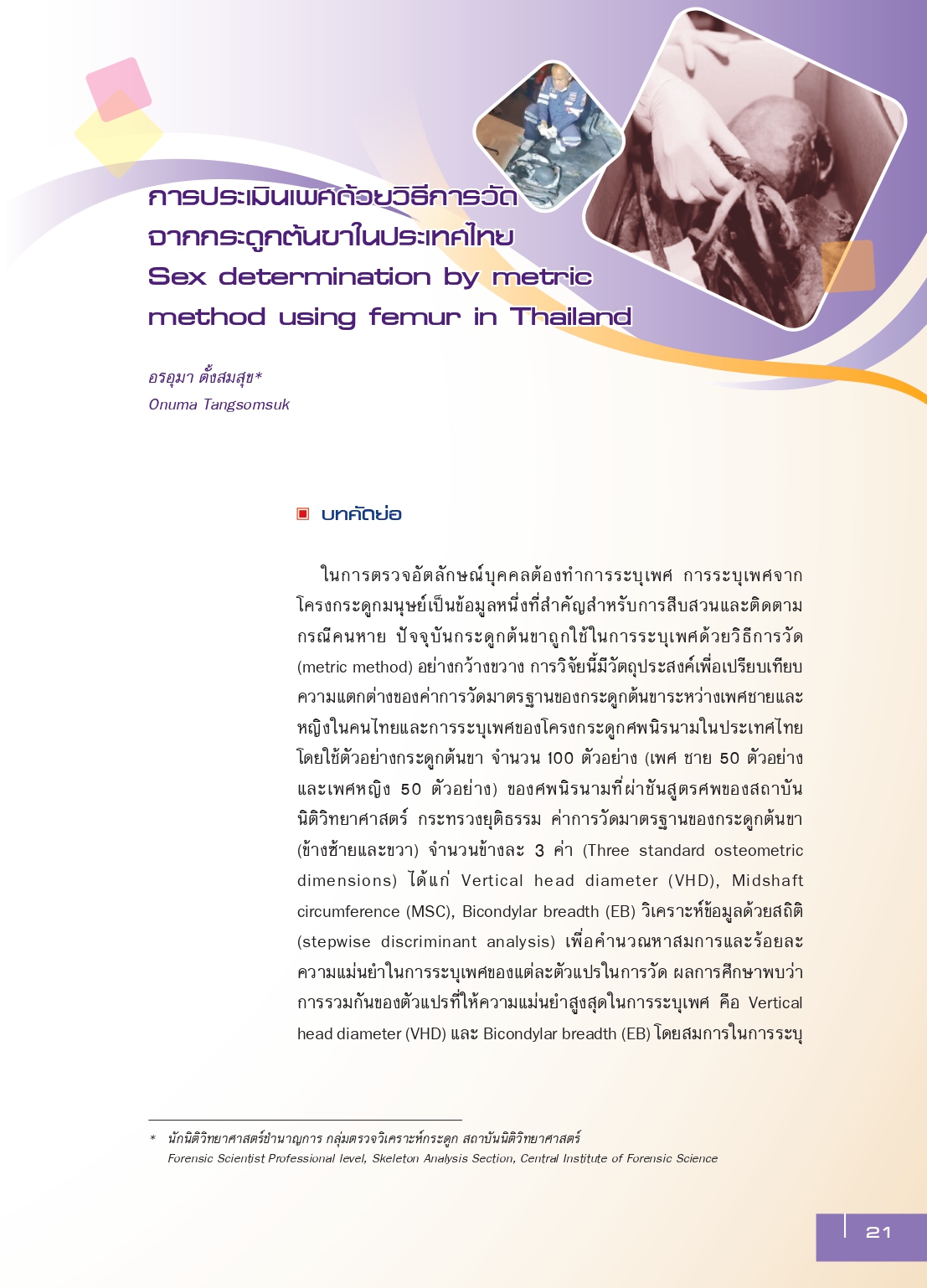Sex determination by metric method using femur in Thailand
Main Article Content
Abstract
Sex is determined in human identity testing. Determination of sex from human skeletal remains provides crucial investigation and assists tracking of missing persons. Currently, it is reported that sex can be determined from femur by metric method. The aim of this research is to compare the differences of standard measurements between male and female femur and the sex determination of the unidentified human skeletal remains in Thailand from a total number of 100 samples (50 males and 50 females) under the possession of the Central Institute of Forensic Science, Ministry of Justice. Three standard osteometric dimensions, the vertical head diameter (VHD), midshaft circumference (MSC) and bicondylar breadth (EB), were measured from both left and right femurs. Then, stepwise discriminant analysis was carried out to determine the equation and percentage of accuracy for each variable. Results revealed that vertical head diameter (VHD) and bicondylar breadth (EB) are the optimal combination with highest accuracy for sex diagnosis. Equations for the determination of sex from left and right femurs are DS = 0.181VHDL + 0.227EBL – 24.762 and DS = 0.176VHDR + 0.231EBR - 24.909, respectively. Direct method analysis using predetermined univariate and multivariate variables revealed that bicondylar breadth of left femur (EBL) was the best variable (94% accuracy in males and 100% accuracy in females); and the multivariate variables under all three osteometric dimensions showed 97-98% accuracy of sex determination from left and right femurs.
Article Details

This work is licensed under a Creative Commons Attribution-NonCommercial-NoDerivatives 4.0 International License.
Published Manuscripts are the copyright of the Journal of the Justice System. However; the opinions that appeared in the content are the sole responsibility of the author.
References
Alunni-Perret, V., Staccini, P., & Quatrehomme, G. (2008). Sex determination from the distal part of the femur in a French contemporary population. Forensic Sci. Int, 175(2-3), 113-117.
Bayer, S. T. (2002). Introduction to forensic anthropology a textbook. Boston: A Pearson Education Company.
Black, T.K. (1978). A new method for assessing the sex of fragmentary skeletal remains: femoral shaft circumference. Am J Phys Anthropol, 48(2), 227-232.
Buikstra, J. E., & Ubelaker, D. H. (1994). Standards for Data Collection from Human Skeletal Remains: Proceedings of a Seminar at the Field Museum of Natural History, Organized by Jonathan Haas. Arkansas Archeological Survey Research Series. No. 44. fayetteville , Arkansas: Arkansas Archeological Survey.
Curate, F., Umbelino, C., Perinha, A., Nogueira, C., Silva, A.M., & Cunha, E. (2017). Sex determination from the femur in Portuguese populations with classical and machine-learning classifiers. Journal of Forensic and Legal Medicine, 52, 75-81.
Chatterjee, P.M., Krishan, K., Singh, R.K., & Kanchan, T. (2020). Sex estimation from the femur using discriminant function analysis in a Central Indian population. Med Sci Law, 60(2),112-121.
DiBennardo, R., & Taylor, J. V. (1982). Classification and misclassification in sexing the black femur by discriminant function analysis. Am J Phys Anthropol, 58(2), 145-51.
Dittrick, J., & Suchey, J. M. (1986). Sex determination of prehistoric central California skeletal remains using discriminant analysis of the femur and humerus. Am J Phys Anthropol, 70(1), 3-9.
Duric’, M., Rakocevic’, Z., & Donic’, D. (2005). The reliability of sex determination of skeletons from forensic context in the Balkans. Forensic Sci Int, 147(2-3), 159-164.
Iscan, M. Y., & Miller-Shaivitz, P. (1984). Determination of sex from the femur in blacks and whites. Coll Antropol, 8(2), 169-175.
Iscan, M. Y., & Ding, S. (1995). Sexual dimorphism in the Chinese femur. Forensic Sci Int, 74(1-2), 79-87.
King, C. A., Can, M. Y., & Loth, S .R. (1998). Metric and comparative analysis of sexual dimorphism in the Thai femur. Journal of Forensic Science, 43(5), 954-958.
Langley, N. R., & Tersigni-Tarrant, MT. A. (2017). Forensic anthropology – A comprehensive introduction (2nd edition). CRC Press Taylor & Francis Group.
MacLaughlin, S. M., & Bruce, M. F. (1985). A simple univariate technique for determining sex from fragmentary femora: its application to a Scottish short cist population. Am J Phys Anthropol, 67(4), 413–417.
Monum, T., Prasitwattanseree, S., Das, S., Siriphimolwat, P., & Mahakkanukrauh, P. (2017). Sex estimation by femur in modern Thai population. Clin Ter, 168(3), 203-207.
Phenice, T. W. (1969). A newly developed visual method of sexing the os pubis. Am J Phys Anthropol, 30(2), 297-301.
Purkait, R., & Chandra, H. (2004). A study of sexual variation in Indian femur. Forensic Sci Int, 146(1), 25-33.
Steyn, M., & Iscan, M. Y. (1998). Sex determination from the femur and tibia in South African Whites. Forensic Sci Int, 90(2), 111-119.
Tagaya, A. (1987). Interpopulation variation of sex differences: an analysis of the extremity long bone measurement of Japanese. J Anthropol Soc Nippon, 95(1), 45-76.
Taylor, J. V., & DiBennardo, R. (1982). Determination of sex of white femora by discriminant function analysis forensic science applications. J Forensic Sci, 27(2), 417-423.
Timonov, P., Fasova, A., Radoinova, D., Alexandrov, A., & Delev, D. (2014). A study of sexual dimorphism in the femur among contemporary Bulgarian population. Euras. J. Anthropol, 5(2), 46-53.
Trancho, G., Robledo, B., Lo´pez-Bueis, I., & Sa´nchez, J. A. (1997). Sexual determination of the femur using discriminant functions analysis of a Spanish population of known sex and age. J Forensic Sci, 42(2), 181-185.
Wu, L. (1989). Sex determination of Chinese femur by discriminant function. J Forensic Sci, 34(5), 1222-1227.


